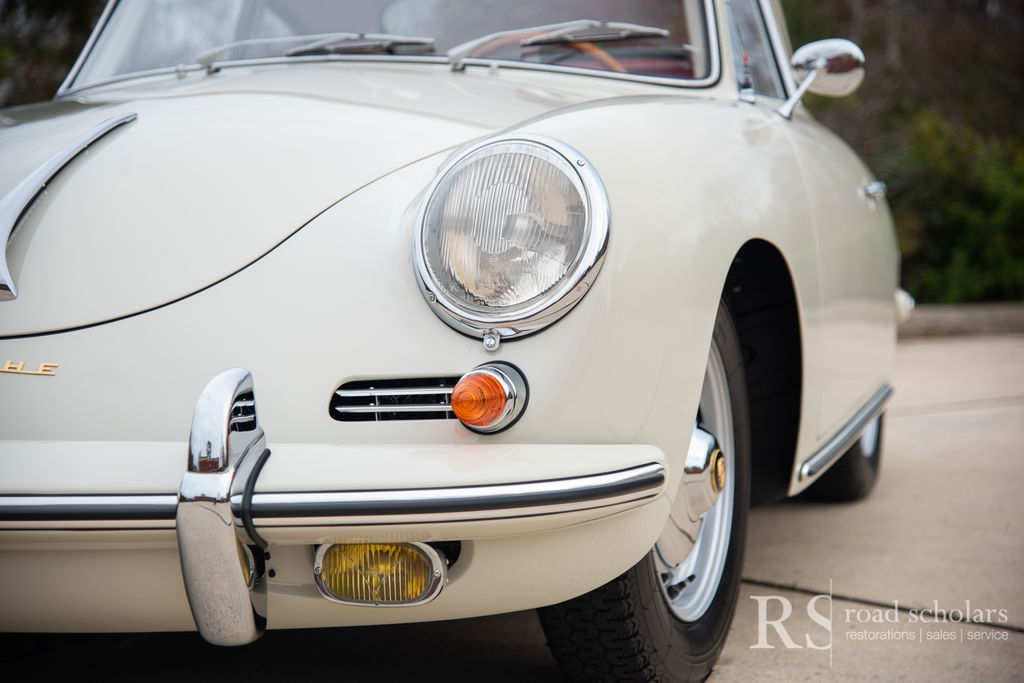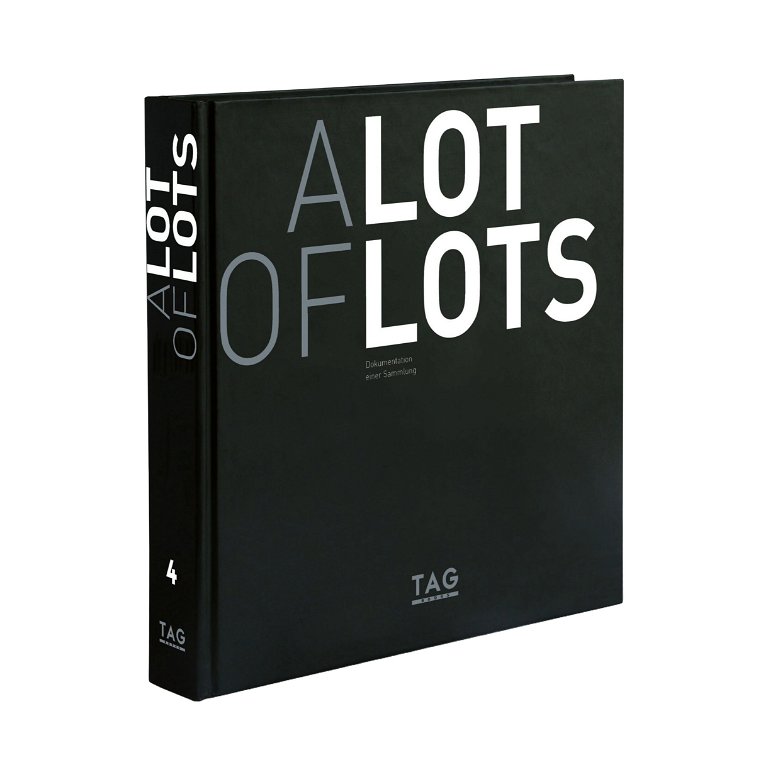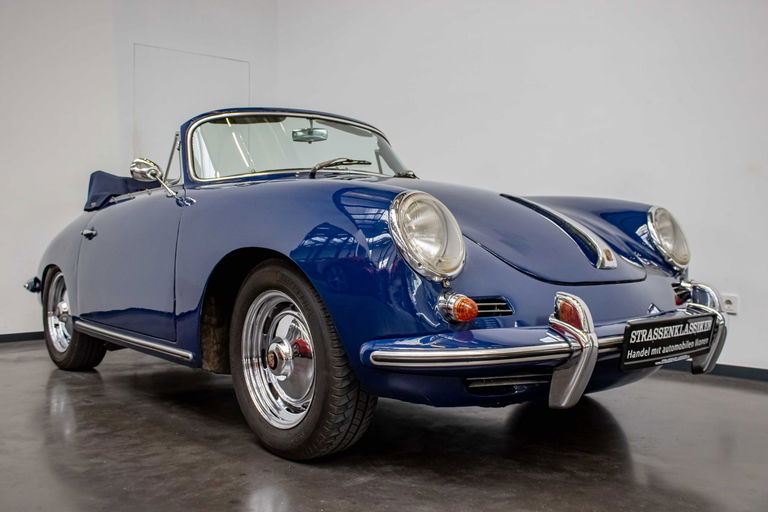For the T5 body, engineers raised the headlight height to improve illumination and also better comply with regulations in many countries in which they sold cars. Bumpers followed, coming up 95mm (3.74 inches) to match other cars. For greater effectiveness, they increased the size of the front marker lights, and projected them a bit further out from the fender swell. The adjacent horn grilles grew longer and flatter, and matching grilles below the bumper masked oval brake air inlets. They suspended optional fog lights just in front of these spaces. A new, wider, distinctively shaped chrome handle replaced the original 356A handle on the front deck lid. Engineers also elevated the rear bumper by 105mm (4.13 inches) and cleverly routed the dual exhaust pipes through the redesigned vertical over-riders. Less visible were the cooling fins cast perpendicularly on the brake drum castings to catch more air and improve brake cooling.
A new three-spoke steering wheel and a shift lever shortened by 40mm (1.57 inches) were two of the more obvious interior changes, although the front seats quickly proved more comfortable and more supportive than in the 356A models. The rear seats split to fold independently and they were recessed an additional 60mm (2.36 inches) to increase legroom slightly. Opening front quarter windows on the coupes enhanced interior air ventilation.
When the German enthusiast magazine Auto Motor und Sport tested the three pushrod-engine 356B models after the Super 90s first appeared, they published performance figures that made the S90 particularly appealing for the time. Acceleration from 0 to 62mph took 13.6 seconds, nearly two seconds faster than the 1600 Normal and a second quicker than the Super. The magazine recorded top speeds of 102mph for the Normal, 109 for the Super, and 117 for the S90.
Production started out very typically for the new model year and for this new model in particular. The first two cars off the Zuffenhausen line were 1600 Normals. Then came this chassis, #108921, the first Super 90 coupe, fitted with engine 800.101 and gearbox 32010. It went straight across the compound for additional testing, issued to an engineer named Klink. It journeyed to Berlin on September 10, 1959, but then returned to the repairs department for updates and modifications on the 19th at 2,919 kilometers. It recycled through the shops again on October 14th at 5,697 kilometers, November 10th at 8,861 kilometers, and a final visit on December 12 at 13,397 kilometers. The Kardex record reveals that all work was finished and signed off on New Year’s Eve 1959. Soon after that, it and a couple of its siblings boarded ships bound for the U.S., for its new life as a distributor demonstrator model, but not until its last modifications in the repairs department replaced the metric gauges with U.S. instruments.
Ironically, the car and its first private owner may have just missed each other in Germany. Emil Beck Pardee was a Porsche racer who also was a partner in a Volkswagen/Porsche dealership, Pardee & Mozart, in Palo Alto, California. (Gus Mozart had opened California’s first VW dealership, in Los Altos in 1954. He moved to a bigger facility on El Camino Real in Palo Alto in 1955 where his partnership with Pardee began.) Pardee had come to Germany for a Volkswagen dealer trip and when the group finished their activities at a location near Munich, Pardee’s friend, Robert Hansen, who worked for the Porsche distributor for northern California, suggested the two of them visit the factory in Zuffenhausen. As Pardee explained in a letter to a friend dated April 1, 1997, they went “to discuss the Super 90 allocations.” They met with Wolfgang Raether, Porsche’s sales manager at the time.
“While Bob and Wulffgang met, I drove a new Super 90 on the Autobahn. Upon my return, I asked Wulffgang for one. At that time all cars were allocated.” But Pardee had some clout in the Porsche world. By this time he had competed successfully in SCCA races in a 1957 Carrera GS-GT coupe, taking a first at Cotati in northern California that year, and a 1958 1600 Carrera Speedster with a number of podium finishes through that season. Through 1959, he ran a 718 RSK that he modified to accommodate wider wheels. Raether found a car for Pardee.
“I was offered a S-90 factory car that was damaged, but in repair, which I accepted. And the car was shipped to San Francisco.” He registered the car at 87 Encina Avenue in Palo Alto.
“As I remember the car it was off white (ivory) with a sunroof,” he wrote, “had U.S. instruments, and long gears (Nurburg Ring-Rations).”
Pardee spent a lot of time running through those Nürburgring gears. Through 1961, he campaigned his S90 on nine separate occasions in SCCA regional events in northern California. Countless racing programs record the entry information: Car #36, Emil Pardee, Porsche 356B S90, White, 1582cc, class C production, license category: Senior.
A Porsche Club newsletter from June 1961 reported the results of one such contest under the heading “Porsche in Competition:”
“Sacramento California race results show PCAers knock ‘em off. Walt Davis and Don Wester finished first and second in the B production dash, while Emil Pardee, who has shifted from Spyders to a Super 90, won C production.”
Pardee eventually sold the coupe to someone he knew in Reno, and the Super 90 circulated in the used car market for decades. Then, in October 2010, a call came in to Road Scholars about a “nice solid car that could be restored if needed but ran well.” Cam Ingram and Kevin Watt were so excited about its credentials as The First Super 90 – with a sun roof – that they broke Rule Number One: Never Buy a Car Sight Unseen.
As they explained, soon after it arrived, “storm clouds gathered. What appeared to be a good driver actually showed signs of damage in the front trunk – bent inner fenders, kinked access panels and – to top it of – one headlight was about an inch higher than the other.”
To repeat: Rule Number One: Never Buy A Car Sight Unseen. How is it that “experts” miss – or misrepresent so great a degree of damage accompanied by poor repair work, they wondered? Cam’s staff spent the next few weeks carefully stripping the car down to bare metal. And to their pleasant surprise, they discovered a few interesting details.
Emile Pardee’s “ivory” Super 90 was not originally off-white but instead, it was painted Heron Gray. Every nook and cranny of the tub revealed abundant evidence of Heron Gray. What’s more, the doorpost hinge posts were hooded, and they found many shims used to hang the door. They recognized these as sure signs of an early production edition.
Road Scholars had an excellent T5 available to them, so they scanned it and had a 3D CAD drawing made of the scans, and then commissioned new body bucks. Pardee’s legendary car then got media blasted. And another “issue” came to light.
This Super 90’s front axle had been pushed back two inches on the left side. And then up more than an inch. Race damage? Testing damage from Zuffenhausen? Crash damage as a demonstrator soon after it arrived in the U.S.? There were no answers, only more questions, problems, and reality. All the bent sheet metal simply had been brazed together some 50-odd years ago. No one had straightened it, replaced it, or even bothered to square it. As Cam said at the time, “Front left tire wear must have been awesome!” The body also had the expected minor rust issues. Facing all this work, the Road Scholars crew set the car on a jig, and the cutting, straightening, re-jigging, and welding commenced.
Once the chassis was repaired properly so it sat dead-straight, the Road Scholars team turned their attention to the car body. They formed a new nose and fenders over Road Scholars’ bucks. They de-kinked and re-skinned the front deck lid and fabricated doors from scratch. They removed the rear body section, repaired the rust damage, and then straightened and refitted the bodywork.
As Cam recalled, “so, now we have thousands of hours just in metal work. But the ‘first Super 90′ is straight and true for the first time since it left Zuffenhausen.” With this owner history – Pardee’s races and his involvement with Porsche and VW as a successful dealer – Cam and his staff have been able to repair and restore an interesting Porsche story that otherwise might have ended badly. Pardee had written about the car’s history to a friend named Jack on April 1, 1997. He died just three months later, on July 7, at age 74.
Scrap yards all over the world – as well as back yards and garages – are strewn with racing cars and with road cars that have a racing history that is so badly damaged that uninformed collectors or unwilling restorers walk up, sigh, and walk on. Restoring Super 90 number 108921 preserves not only the first Porsche 356B Super 90 but it also brings back into critical focus the contribution its first owner made to racing history and, on a larger scale, the role racing in America played in the development of Porsche automobiles.
The word “unique” is abused, often with modifiers that make no sense: most unique, very unique, especially unique, extremely unique. The word means “The only one of its kind.”
That would be this 1960 Porsche 356B Super 90, number 108921. The first. With the first engine, 800.101. A whole generation of desirable cars came after this.






































































































